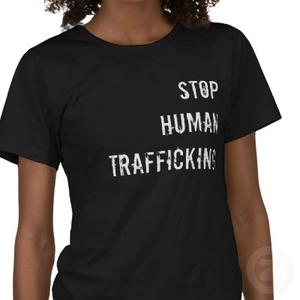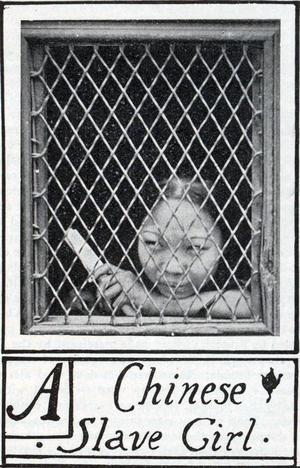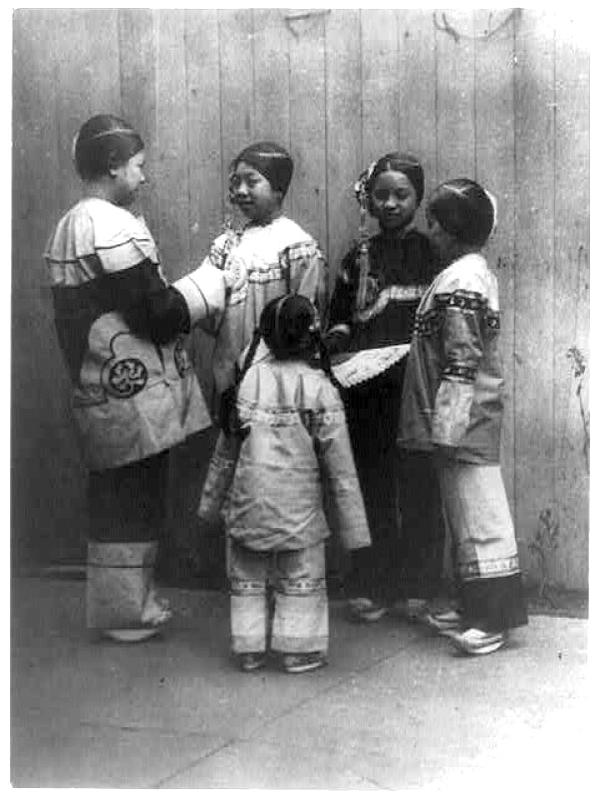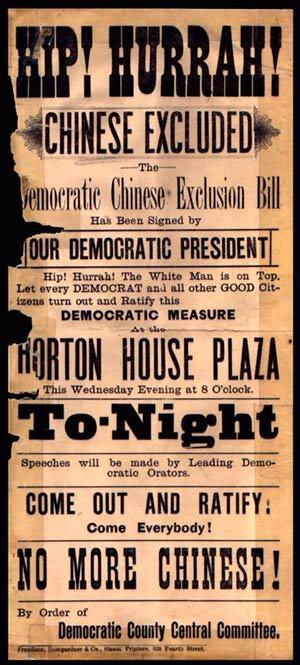
Over the last two decades, many national governments and a variety of non-governmental organizations have sounded a loud drumbeat against “human trafficking”—the transporting and harboring of people through coercive means in order to exploit their labor. But as a recent article on the U.S. Customs and Border Protection (CBP) agency website demonstrates, anti-trafficking rhetoric has deep roots—ones inimical to the wellbeing of migrants.
Titled, “Did You Know... Customs and Immigration Officers Helped 'kidnap' Chinese Girls to Save Them,” the article recycles old stereotypes of gullible Chinese women and villainous Chinese men, and is peopled with chivalrous and swashbuckling white border guards (the precursors of today’s immigration police).
With a view toward justifying its present-day practices of exclusion, the CBP presents an utterly antiseptic view of racist and sexist immigration restrictions against migrants from China in the late 19th and early 20th centuries. Long and intense interrogations (often lasting months and, in some cases, years) by immigration officials are presented as uncovering the lies hatched by “evil Chinese traffickers.” Kidnapping and incarcerating women and girls from China is portrayed as protecting them from their Chinese “captors,” and deportation is seen as the ultimate form of protection bestowed upon them, courtesy of a caring U.S. government.
This story is reality utterly turned on its head. Migrants, by definition, want to move. Yet, the CBP tells us that the very things that migrants fear most—detection, detention, and deportation—are precisely what migrants need and want. It does so by presenting “traffickers” as the greatest problem they face. This is nation-state-speak. Falling for it is a trap that women’s and migrants’ rights advocates must avoid.
Whether a century or more ago or in the present, the effect of Washington’s anti-trafficking propaganda is to absolve the U.S. apparatus of exclusion of any responsibility for the suffering and exploitation of migrants. It also helps to render invisible the fact that in the face of U.S. immigration laws intended to restrict their mobility, people needing and wanting to move will try their best to circumvent them.
Denying such inconvenient truths helps erase the fact that U.S. restrictions—along with massive displacements within China (some caused by imperialist actions of the United States itself)—more or less guaranteed a trade in falsified immigration or residency papers in the case of Chinese exclusion from the late 1800s through the early 1900s. Such denial also facilitates the portrayal of U.S. authorities as the rescuer of Chinese women and girls.
Furthering this project is the negation of the well-documented fact that some women did seek work in the sex industry as part of their efforts to gain a livelihood and support their communities. Infantilizing women from China—by denying their agency—and vilifying those who helped them enter the United States is central to legitimizing racist and sexist immigration restrictions.
In one particularly stunning and emblemati c passage of the CBP article, anti-trafficking rhetoric works to legitimate actions against migrants in the name of protecting them. “Several officers in San Francisco found ways around the legal restrictions,” it reads, “sometimes acting without official sanction. When they suspected a girl was doomed to a life of prostitution, they tipped off local church-sponsored rescue missions that she needed their help. Agents like John Robinson actively participated in raids on brothels to rescue the women. Collector John P. Jackson not only accompanied rescue operations, but also testified against traffickers in court.”
c passage of the CBP article, anti-trafficking rhetoric works to legitimate actions against migrants in the name of protecting them. “Several officers in San Francisco found ways around the legal restrictions,” it reads, “sometimes acting without official sanction. When they suspected a girl was doomed to a life of prostitution, they tipped off local church-sponsored rescue missions that she needed their help. Agents like John Robinson actively participated in raids on brothels to rescue the women. Collector John P. Jackson not only accompanied rescue operations, but also testified against traffickers in court.”
Stories like this, far from illustrating a “rescue” instead serve to prop up the state by legitimizing its measures against people migrating from China. In order to avoid accountability for creating the very conditions that made clandestine migration strategies necessary in the first place, the federal government invented the category of the “evil Chinese trafficker” to mystify the process.
In doing so, extrajudicial actions on the part of U.S. officials were glorified. So, too, were the state’s efforts to deny those women who wished to work in the sex industry the ability to do so and to incarcerate any female migrant from China, often with the goal of deporting them—the main consequence of such “rescue missions.”
In this CBP story, the Immigration Act of 1875 (Page Act) is mentioned but without any discussion of its racist and sexist intentions or effects. Slyly using the rhetoric of anti-slavery and, once again, done in the name of “protecting” migrants, the Page Act prohibited the immigration of workers arriving on “coolie” labor contracts from "China, Japan, or any Oriental country."
Rather than recognize that workers employed as indentured laborers are generally “cheaper” than those who are not, the Page Act was premised on the notion that it was a person’s “Chinese-ness” that made them “cheap.” Thus, instead of Washington banning unfree employment relations outright, it banned “Asian” workers. By institutionalizing racism, the actual processes that cheapened the labor of migrants from China, such as their exclusion from labor, civil, and other rights, were obscured and depoliticized.
The Page Act also specifical ly restricted the immigration of women from China. It did so by creating a new category of female migrant—the “Chinese prostitute”—who was barred from entering the United States.
ly restricted the immigration of women from China. It did so by creating a new category of female migrant—the “Chinese prostitute”—who was barred from entering the United States.
As scholar Eithne Luibheid has shown, the Page Act allowed state officials to make highly discretionary judgments about Chinese women’s “proper” or “improper” conduct, judgments very much influenced by the country’s broader racist and sexist culture. By differentiating among women on how they used (or allegedly used) their sexual labor, the Page Act reproduced the heteropatriarchal wife/prostitute dichotomy within U.S. immigration (and other) law.
Legitimized through the rhetoric of protecting Chinese women from prostitution, the Page Act actually worked to prevent their independent migration and that by women seeking to marry Chinese men already in the United States. The effect of the Page Act–and the actions of those enforcing it–was, therefore, the reduction in opportunities for all women from China to immigrate to the United States.
This was a particularly important public policy goal, because all children born in the United States would automatically become citizens under the 14th Amendment (of 1868). Hence, in the aftermath of the abolition of slavery in the United States, the Page Act was a crucial part of the state’s efforts to reconstruct a society in which citizenship remained restricted to those racialized as ”white.”
The portrayal of both women and men from China as deviating from sexual norms was absolutely central to the fabricated correlation between whiteness and civilization. Indeed, the dual images of the Chinese female “sex slave” (to use today’s anti-trafficking rhetoric) and the sexually depraved Chinese male were key to the construction of people from China as a “yellow peril.” As the writer Luc Sante has illustrated, in the quarter century before the 1875 Page Act, one of the most popular—and grossly overstated—complaints against Chinese residents in the press and in state-speak was their alleged involvement in prostitution, either as slaves or as enslavers.
Even the other major negative stereotype of people from China—that they were opium addicted zombies—was a way to talk about the supposedly different sexual norms of “the Chinese” and “the whites” and the “dangers” of the former to the latter. The historian Diane Ahmad reports that white doctors even claimed that opium smoking led to increased involvement in prostitution by young white women and to genetic contamination via miscegenation, or racial mixing.
Such racialized differentiations were a crucial part of how restrictions against Chinese migrants—male and, especially, female—were legitimated. These ideas were firmly embedded, and institutionalized into U.S. law, by the Page Act.
It also paved the way for the 1882 Chinese Exclusion Act, the first federal immigration law to prohibit immigration on the basis of ideas of “racial” inferiority. The bill barred all working class persons from China, regardless of whether or not they came on unfree labor contracts and whether or not they worked, or intended to work, in the sex industry. Renewed in 1892, it was extended indefinitely in 1902, and not repealed until 1943.
Along with the 1888 Scott Act—which established that Chinese migrants, even when they had entered and had been living in the country legally, could not re-enter after leaving U.S. territory—these laws intensified the need for people to seek unofficial means of entering the United States. Indeed, one of the effects of the Chinese Exclusion Act, points out sociologist Sheldon Zhang, along with the National Origins Act of 1924 that severely limited the number of elite migrants who could migrate from China, was the commercialization of clandestine migration.
These immigration restrictions, and the officers who enforced them, did not operate in isolation from other U.S. laws. In the late 19th and until the mid-20th century, migrants from China were prohibited from becoming U.S. citizens. In 1889, an Anti-Miscegenation Act prohibited men racialized as “Chinese” from marrying “white” women. And a 1927 U.S. Supreme Court decision (Lum v. Rice) legalized the segregation of “yellow” children in educational institutions.
Alongside the racism and sexism of U.S. law, were the everyday acts of violence, discrimination, and denigration targeting persons racialized as “Chinese.” Within this context, the “rescuing” rhetoric of U.S. immigration (or customs) officials rings decidedly hollow.
Ultimately, this story of past “rescue missions” is told in order to brag about current U.S. efforts at “ending trafficking.” “To this day, CBP continues to combat human trafficking,” the article boasts. It then proceeds to give examples of particular initiatives as part of that effort to convince us that the state, through its anti-trafficking laws, is going to protect migrants by controlling and limiting their migration and by detaining and, usually, deporting them “back home.”
It is not a coincidence that in a world where more people than ever before need to, and want to, migrate and where the immigration laws of “rich world” countries, like the United States, have become ever-more restrictive, that the U.S. state has since 2000 once again trotted out “anti-trafficking” laws and the overblown rhetoric of “rescuing victims of trafficking” to legitimate draconian measures against migrants.
In behaving this way, the United States and indeed the entire global system of national states tries to escape accountability for creating unsafe conditions for people attempting to migrate away from a number of politically, economically, and socially violent—or otherwise untenable—situations. They also evade responsibility for constructing a system that is nothing short of a global apartheid: one where immigration and citizenship in the “rich world” remains elusive for all but a few and is especially restrictive for women .
.
Getting authorized resident status in the United States today, for example, is next to impossible for most of the world’s migrants. Since the reasons that people move is not mitigated by such restrictions, the largest category of migration to the United States has become that of “illegal.” Indeed, it is larger than all of the categories of “legal” migration combined.
Although obviously racist and sexist language is not (officially) used today, the rhetoric of “trafficking” still relies on many of the same assumptions. While “traffickers” are no longer represented as “evil Chinamen,” they are said to be part of “foreign criminal syndicates,” even though there is scant evidence to show this. In fact, as in the late-1800s and early-1900s, most clandestine migration operations are small-scale and migrants most often receive help from a network of family members or other associates to move.
The “victims of trafficking,” however, remain caught in the same language of those bygone times. Once again, they are the “poor and uneducated” women from what is now referred to as the “global South.”
Kathleen Barry, one of the founders of the Coa lition Against Trafficking in Women, for instance, argues that while any woman could potentially become a “sex slave,” the most vulnerable occupy what she believes is a lower stage of economic and feminist development. Relying on and reproducing earlier imperialist rhetoric that linked the status of women to a global hierarchy of “race” and “civilization,” Barry states that such a lower stage “prevails in pre-industrial and feudal societies that are primarily agricultural and where women are excluded from the public sphere.” They are places where “Third World women” are the “exclusive property of men.”
As in the past, today’s anti-trafficking practices are done in the name of “saving women” from “their men.” Once again the state evades all responsibility, and what we get is the detection, detention, and deportation of women and girl migrants.
As I’ve argued elsewhere, instead of objectifying women and girl migrants through the state category of “victims of trafficking,” we need to expose the role of the state in creating dangerous migration routes and discriminatory legal and social environments for them.
Ultimately, what migrants want to do is move and to move safely. Like “citizens,” they want full access to the means of life. Listening to migrants means working to eliminate all immigration and border controls and all distinctions between “citizens” and “migrants.” Only in this context can we counter preposterous claims by states that migration and citizenship controls are what are best for migrants.
Nandita Sharma is an Associate Professor in the Department of Sociology at the University of Hawaii at Manoa. She is the author of Home Economics: Nationalism and the Making of 'Migrant Workers' in Canada. She can be reached at nsharma@hawaii.edu.

